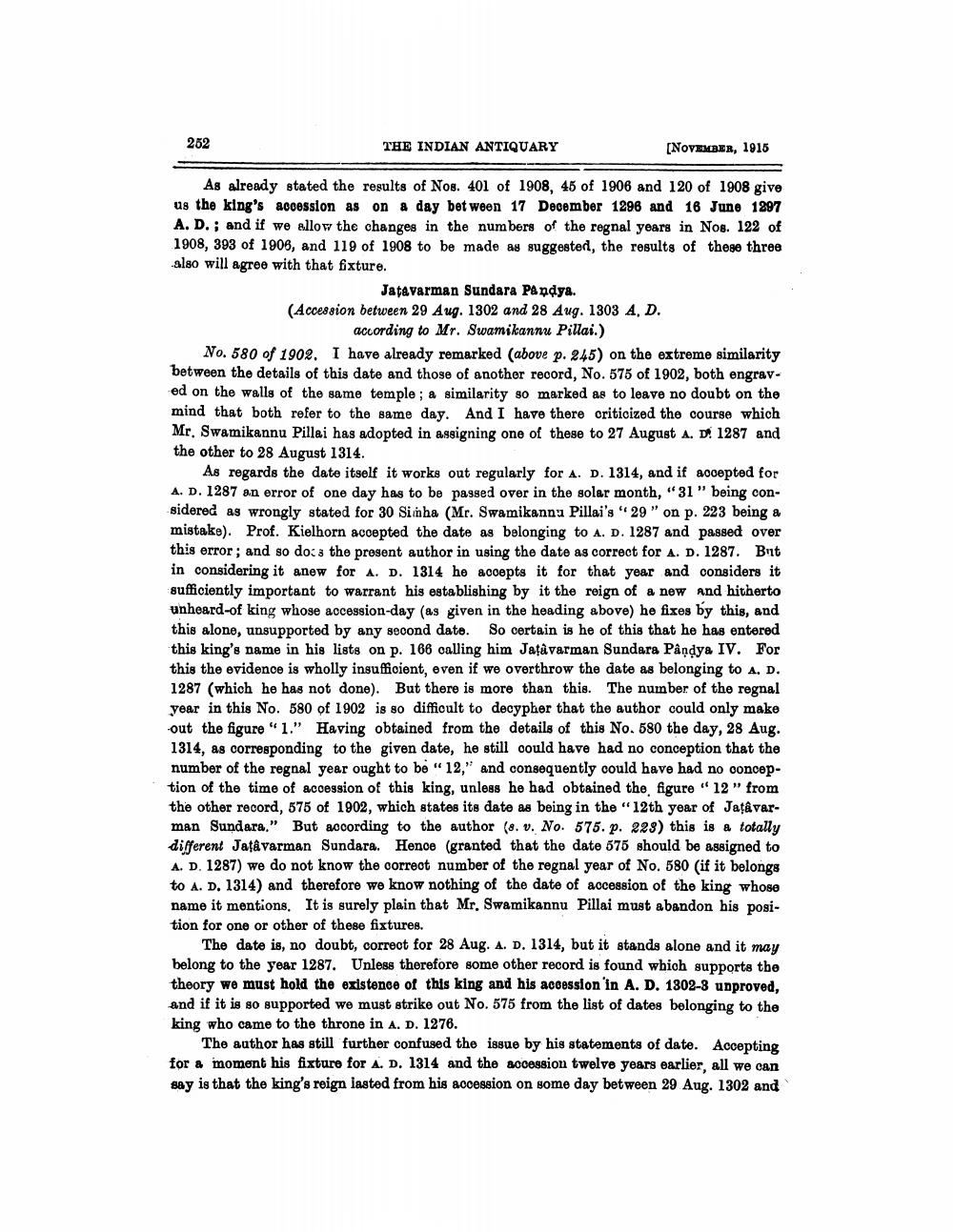________________
252
THE INDIAN ANTIQUARY
(NOVEMBER, 1915
As already stated the results of Nos. 401 of 1908, 45 of 1906 and 120 of 1908 give us the king's accession as on a day between 17 December 1296 and 16 June 1297 A. D.; and if we allow the changes in the numbers of the regnal years in Nos. 122 of 1908, 393 of 1906, and 119 of 1908 to be made as suggested, the results of these three also will agree with that fixture.
Jatavarman Sundara Pandya. (Accession between 29 Aug. 1302 and 28 Aug. 1303 A, D.
according to Mr. Swamikannu Pillai.) No. 580 of 1902. I have already remarked (above p. 245) on the extreme similarity between the details of this date and those of another record, No. 575 of 1902, both engraved on the walls of the same temple; a similarity so marked as to leave no doubt on the mind that both refer to the same day. And I have there criticized the course which Mr. Swamikannu Pillai has adopted in assigning one of these to 27 August A. D. 1287 and the other to 28 August 1314.
As regards the date itself it works out regularly for A. D. 1314, and if accepted for A. D. 1287 an error of one day has to be passed over in the solar month,"31" being considered as wrongly stated for 30 Simha (Mr. Swamikannu Pillai's " 29" on p. 223 being a mistake). Prof. Kielhorn accepted the date as belonging to A. D. 1287 and passed over this error; and so do: a the present author in using the date as correct for A. D. 1287. But in considering it anew for A. D. 1314 he accepts it for that year and considers it sufficiently important to warrant his establishing by it the reign of a new and hitherto unheard-of king whose accession-day (as given in the heading above) he fixes by this, and this alone, unsupported by any second date. So certain is he of this that he has entered this king's name in his lists on p. 166 calling him Jatavarman Sundara Pandya IV. For this the evidence is wholly insufficient, even if we overthrow the date as belonging to A. D. 1287 (which he has not done). But there is more than this. The number of the regnal year in this No. 580 of 1902 is 80 difficult to decypher that the author could only make out the figure “1." Having obtained from the details of this No. 580 the day, 28 Aug. 1314, as corresponding to the given date, he still could have had no conception that the number of the regnal year ought to be " 12,' and consequently could have had no conception of the time of acoession of this king, unless he had obtained the figure " 12" from the other record, 575 of 1902, which states its date as being in the "12th year of Jatâ varman Sundara." But according to the author (8. v. No. 575. p. 223) this is a totally different Jatavarman Sundara. Hence (granted that the date 575 should be assigned to A. D. 1287) we do not know the correot number of the regnal year of No. 580 (if it belongs to A. D. 1314) and therefore we know nothing of the date of accession of the king whose name it mentions. It is surely plain that Mr. Swamikannu Pillai must abandon his position for one or other of these fixtures.
The date is, no doubt, correct for 28 Aug. A. D. 1314, but it stands alone and it may belong to the year 1287. Unless therefore some other record is found which supports the theory we must hold the existence of this king and his accession in A. D. 1802-8 unproved, and if it is so supported we must strike out No. 575 from the list of dates belonging to the king who came to the throne in A. D. 1276.
The author has still further confused the issue by his statements of date. Accepting for a moment his fixture for A.D. 1314 and the accession twelve years earlier, all we can say is that the king's reign lasted from his accession on some day between 29 Aug. 1302 and




